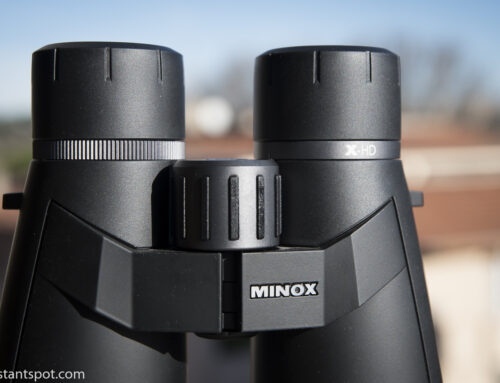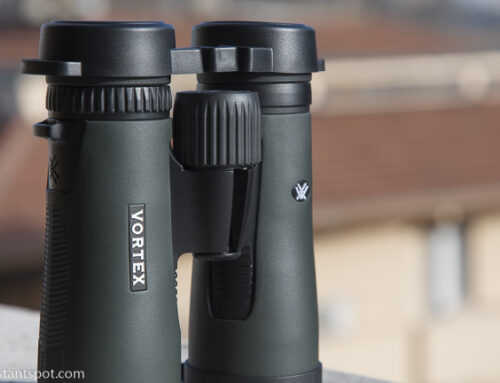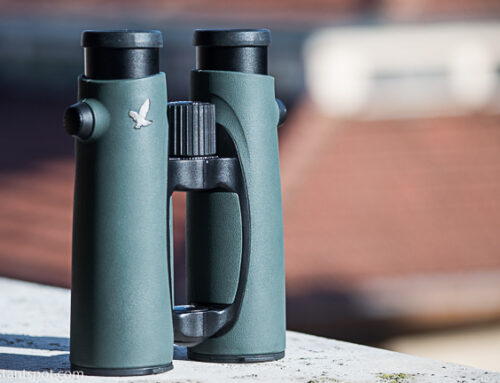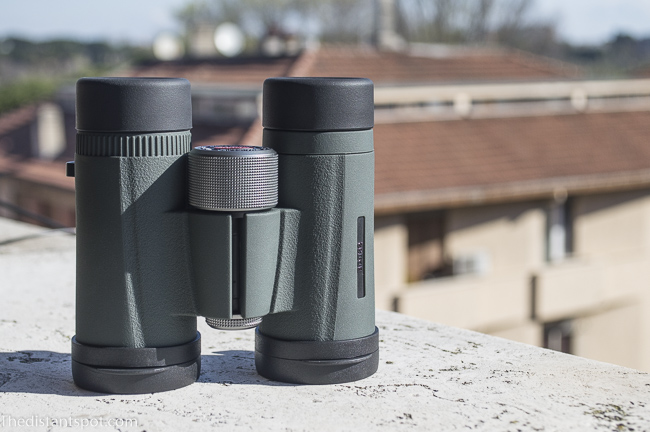Kowa BD II 6.5×32 XD
Intro
These binoculars belong to the new series of Kowa BD binoculars, therefore, despite being different models, I can only compare them with the Kowa BD 8×32 Prominar XD, of which you can find the review on this site and which I consider one of my best purchases. I therefore invite you to reread it for a more detailed comparison.
Construction
The rubber coating of the Kowa BD II 6.5×32 XD is very similar to that of the previous one, even with regard to its design, but it is more rough to the touch and therefore ensures a better grip.
The focus rotor is similar but this time it comes without the red ring and in a slightly darker shade of silver that makes it less flashy: I like it more.
The bridge is a little bit shorter (a few millimeters) and is contoured: these small differences are enough to make the handle much more comfortable.
Another improvement regards the eyepieces, which are a little wider and have a softer rubber.
Unfortunately, the case has worsened: it is bigger despite the binoculars being smaller! From my point of view this is a serious drawback since it makes it much more cumbersome than necessary during transport.
Nevertheless, the building quality of the Kowa BD II 6.5×32 XD is light years ahead of the preceding series.
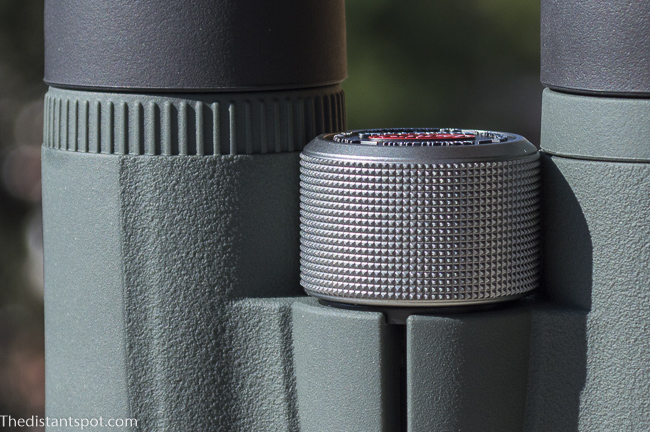
Optical qualities
The field stop is black and quite clear, as it was for the previous series which already showed a good result.
The field of view is huge. This is a very useful feature that makes observation really pleasant. The immersion in the scene is maximum and the boundaries of the image are so far from the center that it seems to be observing with the naked eye. The vision you get is perfect both for targeting a particular subject (such as a bird or a star) and to study the horizon.
Among those in my possession, these are the binoculars with the largest field of view: although by virtue of the higher magnification the Swarovski EL 8.5×42 W B show a similar apparent field, their real field of view is much smaller.
Unfortunately, except for the central part, the field is not correct enough. The correct area seems similar to that of the old Kowa or even smaller. With this model, though, the deterioration at the edges of the image is much more obvious and, in my sample, it is also asymmetrical: the upper part of the frame is more correct than the lower part.
Chromatic aberration
There is little aberration in the center of the image, but it becomes quite strong as soon as you move, even slightly, towards the edge. This is not connected to the larger field of view. Highly contrasted objects, such as antennas against the background of the sky, show an annoying green outline.
The full moon, which was particularly large during my test (super moon), appeared surrounded by a half yellow-green and half violet profile.
The old Kowa was practically perfect in the center and much better at the edge and, even when observing the moon, the colored outline was quite difficult to notice and not particularly bothering.
Sharpness
It is good in the center of the field but the moon begins to lose its sharpness as soon as you leave the exact center of the image.
Again, it seems to me that the first series was slightly superior to this one, with sharper details and greater ease in revealing the texture of the objects.
However, the Pleiades seemed more contrasted than in the old Kowa, with a better separation from the background of the sky.
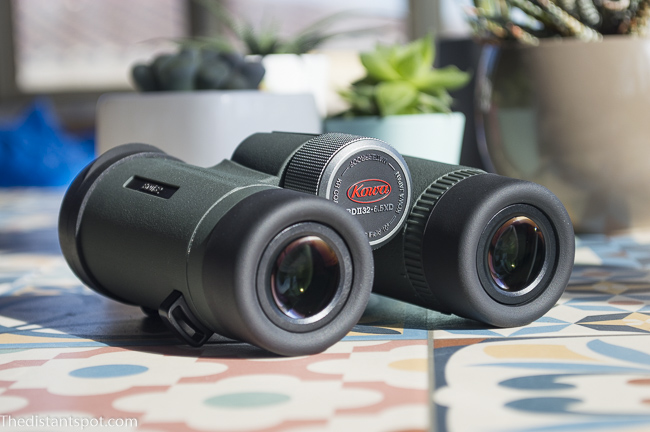
Astigmatism
The stellar punctiformity appears, in general, superior to that exhibited by the old Kowa. And yet Venus, observed during a beautiful conjunction with the Pleiades, did not appear spherical even at the exact center of the image, instead resembling an irregular globe.
Coma
Looking at a star, you can notice quite a good amount of coma even in the center of the image. Since this optical aberration appears off-axis, and gets stronger as you move away from it, this shouldn’t happen. It makes me think that the optical axis of my specimen could be decentralized. By bringing the star to the edge the deformation becomes severe and the star stretches to become a line.
This effect is totally absent on the Kowa BD and even the edge performs better, although it must always be remembered that its field of view is narrower.
Tint
The stars appear well saturated and the colors seem substantially correct, perhaps leaning on the warm side but still in a pleasant way. During the day I did not notice any evident color cast.
Reflections and stray light
Venus, in the center of the image, showed an annoying quadruple spike that was absent in the old Kowa. However, it must be said that in the period of the review Venus was particularly bright and even the Swarovski showed spikes keeping it just outside the center of the image.
The moon, on the other hand, produced both a sort of luminous cylinder that covered the image up to the edge and a ghost reflection on the opposite side of the field. Furthermore, taking it just out of the frame, the vision suffered from very intense stray light. In the Kowa BD there was no light cylinder and the reflections (two) were more contained.
By aiming at a lamppost I was able to observe a curious effect that I had never experienced before: there was a very intense spike which, instead of moving away towards the edge of the image, seemed to point directly towards the binoculars, with a remarkable effect of depth.
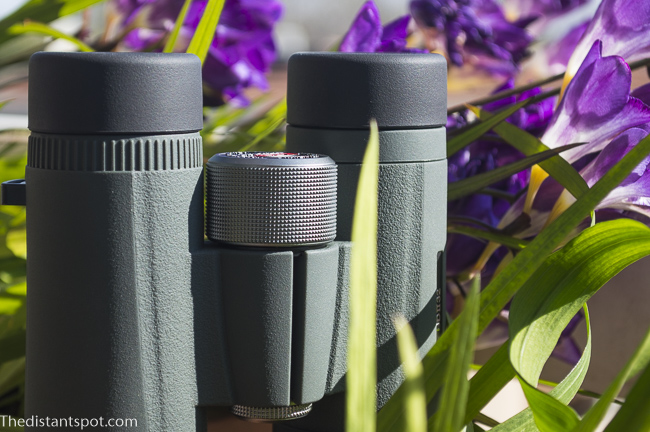
Distortion
Not obvious.
Other aspects
In my review of the Kowa BD 8×32 Prominar XD I wrote of my difficulties achieving a correct positioning of the binoculars to avoid annoying blackouts: to my great pleasure I can testify that, with this sample, I did not have the slightest problem. I have not encountered blackouts and I have never needed to try particularly hard to get a pleasant vision. This adds a lot to the pleasure of observation and makes you reach for the tool even for a quick check or to study a detail on the fly.
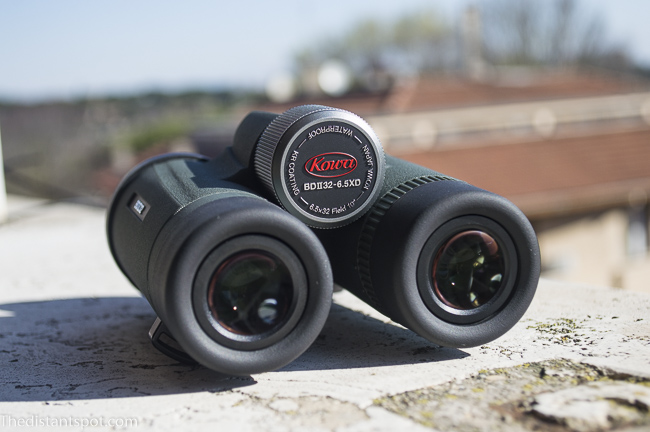
Conclusions
Considering some of the problems that I encountered, it may be that the quality of the sample I reviewed was lower than the average of the entire production.
However I found it on the market, so I believe it is representative of what a customer can get by purchasing this model.
It is an interesting pair of binoculars with great features but, for its price, I expected a higher optical quality.
Compared to the previous model, its construction and ease of use improved a lot, making it much more pleasant to use. Binoculars, however, are optical instruments, and they must be judged on what they can show you.
The Kowa BD II 6.5×32 XD focus entirely on a very large field of view. This choice, however, proved to be penalizing with regard to the other parameters, in which their results are inferior to the previous series.
To their defense, it must be remembered that the Kowa BD 8×32 had an exceptionally high value for money but still, this new version does not bring enough improvements to convince me to make the change.
Kowa BD II 6.5×32 XD
Intro
These binoculars belong to the new series of Kowa BD binoculars, therefore, despite being different models, I can only compare them with the Kowa BD 8×32 Prominar XD, of which you can find the review on this site and which I consider one of my best purchases. I therefore invite you to reread it for a more detailed comparison.
Construction
The rubber coating of the Kowa BD II 6.5×32 XD is very similar to that of the previous one, even with regard to its design, but it is more rough to the touch and therefore ensures a better grip.
The focus rotor is similar but this time it comes without the red ring and in a slightly darker shade of silver that makes it less flashy: I like it more.
The bridge is a little bit shorter (a few millimeters) and is contoured: these small differences are enough to make the handle much more comfortable.
Another improvement regards the eyepieces, which are a little wider and have a softer rubber.
Unfortunately, the case has worsened: it is bigger despite the binoculars being smaller! From my point of view this is a serious drawback since it makes it much more cumbersome than necessary during transport.
Nevertheless, the building quality of the Kowa BD II 6.5×32 XD is light years ahead of the preceding series.

Optical qualities
The field stop is black and quite clear, as it was for the previous series which already showed a good result.
The field of view is huge. This is a very useful feature that makes observation really pleasant. The immersion in the scene is maximum and the boundaries of the image are so far from the center that it seems to be observing with the naked eye. The vision you get is perfect both for targeting a particular subject (such as a bird or a star) and to study the horizon.
Among those in my possession, these are the binoculars with the largest field of view: although by virtue of the higher magnification the Swarovski EL 8.5×42 W B show a similar apparent field, their real field of view is much smaller.
Unfortunately, except for the central part, the field is not correct enough. The correct area seems similar to that of the old Kowa or even smaller. With this model, though, the deterioration at the edges of the image is much more obvious and, in my sample, it is also asymmetrical: the upper part of the frame is more correct than the lower part.
Chromatic aberration
There is little aberration in the center of the image, but it becomes quite strong as soon as you move, even slightly, towards the edge. This is not connected to the larger field of view. Highly contrasted objects, such as antennas against the background of the sky, show an annoying green outline.
The full moon, which was particularly large during my test (super moon), appeared surrounded by a half yellow-green and half violet profile.
The old Kowa was practically perfect in the center and much better at the edge and, even when observing the moon, the colored outline was quite difficult to notice and not particularly bothering.
Sharpness
It is good in the center of the field but the moon begins to lose its sharpness as soon as you leave the exact center of the image.
Again, it seems to me that the first series was slightly superior to this one, with sharper details and greater ease in revealing the texture of the objects.
However, the Pleiades seemed more contrasted than in the old Kowa, with a better separation from the background of the sky.

Astigmatism
The stellar punctiformity appears, in general, superior to that exhibited by the old Kowa. And yet Venus, observed during a beautiful conjunction with the Pleiades, did not appear spherical even at the exact center of the image, instead resembling an irregular globe.
Coma
Looking at a star, you can notice quite a good amount of coma even in the center of the image. Since this optical aberration appears off-axis, and gets stronger as you move away from it, this shouldn’t happen. It makes me think that the optical axis of my specimen could be decentralized. By bringing the star to the edge the deformation becomes severe and the star stretches to become a line.
This effect is totally absent on the Kowa BD and even the edge performs better, although it must always be remembered that its field of view is narrower.
Tint
The stars appear well saturated and the colors seem substantially correct, perhaps leaning on the warm side but still in a pleasant way. During the day I did not notice any evident color cast.
Reflections and stray light
Venus, in the center of the image, showed an annoying quadruple spike that was absent in the old Kowa. However, it must be said that in the period of the review Venus was particularly bright and even the Swarovski showed spikes keeping it just outside the center of the image.
The moon, on the other hand, produced both a sort of luminous cylinder that covered the image up to the edge and a ghost reflection on the opposite side of the field. Furthermore, taking it just out of the frame, the vision suffered from very intense stray light. In the Kowa BD there was no light cylinder and the reflections (two) were more contained.
By aiming at a lamppost I was able to observe a curious effect that I had never experienced before: there was a very intense spike which, instead of moving away towards the edge of the image, seemed to point directly towards the binoculars, with a remarkable effect of depth.

Distortion
Not obvious.
Other aspects
In my review of the Kowa BD 8×32 Prominar XD I wrote of my difficulties achieving a correct positioning of the binoculars to avoid annoying blackouts: to my great pleasure I can testify that, with this sample, I did not have the slightest problem. I have not encountered blackouts and I have never needed to try particularly hard to get a pleasant vision. This adds a lot to the pleasure of observation and makes you reach for the tool even for a quick check or to study a detail on the fly.

Conclusions
Considering some of the problems that I encountered, it may be that the quality of the sample I reviewed was lower than the average of the entire production.
However I found it on the market, so I believe it is representative of what a customer can get by purchasing this model.
It is an interesting pair of binoculars with great features but, for its price, I expected a higher optical quality.
Compared to the previous model, its construction and ease of use improved a lot, making it much more pleasant to use. Binoculars, however, are optical instruments, and they must be judged on what they can show you.
The Kowa BD II 6.5×32 XD focus entirely on a very large field of view. This choice, however, proved to be penalizing with regard to the other parameters, in which their results are inferior to the previous series.
To their defense, it must be remembered that the Kowa BD 8×32 had an exceptionally high value for money but still, this new version does not bring enough improvements to convince me to make the change.


